Potentiometric Sensor Based on Carbon Paste Electrode for Monitoring Total Residual Chlorine in Electrolytically-Treated Ballast Water
Abstract
1. Introduction
2. Materials and Methods
2.1. Reagents and Materials
2.2. Preparation of the Fc-Modified Carbon Paste Electrode (Fc-CPE)
2.3. Potentiometric Measurements
3. Results
3.1. The Effect of Fc
3.2. The Effect of Composition
3.3. The Response Time and Reversibility of the Fc-CPE
3.4. Selectivity Studies
3.5. The Reproducibility, Lifespan, and Storage Stability of the Electrode
4. Conclusions
Author Contributions
Funding
Institutional Review Board Statement
Informed Consent Statement
Data Availability Statement
Conflicts of Interest
References
- Balaji, R.; Yaakob, O.; Koh, K.K. A review of developments in ballast water management. Environ. Rev. 2014, 22, 298–310. [Google Scholar] [CrossRef]
- Tsolaki, E.; Diamadopoulos, E. Technologies for ballast water treatment: A review. J. Appl. Chem. Biotechnol. 2010, 85, 19–32. [Google Scholar] [CrossRef]
- Werschkun, B.; Banerji, S.; Basurko, O.C.; David, M.; Fuhr, F.; Gollasch, S.; Grummt, T.; Haarich, M.; Jha, A.N.; Kacan, S.; et al. Emerging risks from ballast water treatment: The run-up to the International Ballast Water Management Convention. Chemosphere 2014, 112, 256–266. [Google Scholar] [CrossRef]
- Kim, Y.; Aw, T.G.; Teal, T.K.; Rose, J.B. Metagenomic Investigation of Viral Communities in Ballast Water. Environ. Sci. Technol. 2015, 49, 8396–8407. [Google Scholar] [CrossRef] [PubMed]
- Petersen, N.B.; Madsen, T.; Glaring, M.A.; Dobbs, F.C.; Jorgensen, N.O.G. Ballast water treatment and bacteria: Analysis of bacterial activity and diversity after treatment of simulated ballast water by electrochlorination and UV exposure. Sci. Total Environ. 2019, 648, 408–421. [Google Scholar] [CrossRef] [PubMed]
- Olenin, S.; Ojaveer, H.; Minchin, D.; Boelens, R. Assessing exemptions under the ballast water management convention: Preclude the Trojan horse. Mar. Pollut. Bull. 2016, 103, 84–92. [Google Scholar] [CrossRef]
- Min, I.; Hwang, H.; Moon, D.; Lee, J. Implementation of Ballast Water Treatment System using Electrolysis. In Proceedings of the 2013 13th International Conference on Control, Automation and Systems (ICCAS), Gwangju, South Korea, 20–23 October 2013; pp. 1421–1424. [Google Scholar]
- Nanayakkara, K.G.; Zheng, Y.M.; Alam, A.K.; Zou, S.; Chen, J.P. Electrochemical disinfection for ballast water management: Technology development and risk assessment. Mar. Pollut. Bull. 2011, 63, 119–123. [Google Scholar] [CrossRef]
- Liu, G.Z.; Wang, J.M.; Zhang, J.Q.; Cao, C.A. Effect of Electrolytic Treatment of Ballast Water on the Corrosion Behavior of 316l Stainless Steel. Acta Metall. Sin. 2011, 47, 1600–1604. [Google Scholar]
- Lou, X.; Zhang, Y.; Qin, J.; Li, Z. Colorimetric hypochlorite detection using an azobenzene acid in pure aqueous solutions and real application in tap water. Sens. Actuators B 2012, 161, 229–234. [Google Scholar] [CrossRef]
- Adam, L.C.; Gordon, G. Direct and Sequential Potentiometric Determination of Hypochlorite, Chlorite, and Chlorate Ions When Hypochlorite Ion is Present in Large Excess. Anal. Chem. 1995, 67, 535–540. [Google Scholar] [CrossRef]
- Wakigawa, K.; Gohda, A.; Fukushima, S.; Mori, T.; Niidome, T.; Katayama, Y. Rapid and selective determination of free chlorine in aqueous solution using electrophilic addition to styrene by gas chromatography/mass spectrometry. Talanta 2013, 103, 81–85. [Google Scholar] [CrossRef] [PubMed]
- Szili, M.; Kasik, I.; Matejec, V.; Nagy, G.; Kovacs, B. Poly(luminol) based sensor array for determination of dissolved chlorine in water. Sens. Actuators B 2014, 192, 92–98. [Google Scholar] [CrossRef]
- Hallaj, T.; Amjadi, M.; Manzoori, J.L.; Shokri, R. Chemiluminescence reaction of glucose-derived graphene quantum dots with hypochlorite, and its application to the determination of free chlorine. Microchim. Acta 2014, 182, 789–796. [Google Scholar] [CrossRef]
- Salazar, P.; Martín, M.; García-García, F.J.; González-Mora, J.L.; González-Elipe, A.R. A novel and improved surfactant-modified Prussian Blue electrode for amperometric detection of free chlorine in water. Sens. Actuators B 2015, 213, 116–123. [Google Scholar] [CrossRef]
- Senthilkumar, K.; Zen, J.-M. Free chlorine detection based on EC’ mechanism at an electroactive polymelamine-modified electrode. Electrochem. Commun. 2014, 46, 87–90. [Google Scholar] [CrossRef]
- Soundappan, T.; Haddad, K.; Kavadiya, S.; Raliya, R.; Biswas, P. Crumpled graphene oxide decorated SnO2 nanocolumns for the electrochemical detection of free chlorine. Appl. Nanosci. 2017, 7, 645–653. [Google Scholar] [CrossRef]
- Jović, M.; Cortés-Salazar, F.; Lesch, A.; Amstutz, V.; Bi, H.; Girault, H.H. Electrochemical detection of free chlorine at inkjet printed silver electrodes. J. Electroanal. Chem. 2015, 756, 171–178. [Google Scholar] [CrossRef]
- March, J.G.; Gual, M.; Simonet, B.M. Determination of residual chlorine in greywater using o-tolidine. Talanta 2002, 58, 995–1001. [Google Scholar] [CrossRef]
- Ludvig Moberg, B.K. An improved N,N-diethyl-p-phenylenediamine (DPD) method for the determination of free chlorine based on multiple wavelength detection. Anal. Chim. Acta. 2000, 407, 127–133. [Google Scholar] [CrossRef]
- Murray, A.; Lantagne, D. Accuracy, precision, usability, and cost of free chlorine residual testing methods. J. Water Health 2015, 13, 79–90. [Google Scholar] [CrossRef]
- Bujes-Garrido, J.; Arcos-Martínez, M.J. Development of a wearable electrochemical sensor for voltammetric determination of chloride ions. Sens. Actuators B 2017, 240, 224–228. [Google Scholar] [CrossRef]
- Kiss, L.; Kovács, B.; Nagy, G. Direct chronoamperometric determination of free available chlorine in soil samples using built-in diffusion layer coated glassy carbon electrode. J. Solid State Electrochem. 2014, 19, 261–267. [Google Scholar] [CrossRef]
- Pan, S.; Deen, M.J.; Ghosh, R. Low-Cost Graphite-Based Free Chlorine Sensor. Anal. Chem. 2015, 87, 10734–10737. [Google Scholar] [CrossRef] [PubMed]
- Thiagarajan, S.; Wu, Z.-Y.; Chen, S.-M. Amperometric determination of sodium hypochlorite at poly MnTAPP-nano Au film modified electrode. J. Electroanal. Chem. 2011, 661, 322–328. [Google Scholar] [CrossRef]
- Tomei, M.R.; Arduini, F.; Neagu, D.; Moscone, D. Carbon black-based disposable sensor for an on-site detection of free chlorine in swimming pool water. Talanta 2018, 189, 262–267. [Google Scholar] [CrossRef]
- Kumar, D.R.; Kesavan, S.; Nguyen, T.T.; Hwang, J.; Lamiel, C.; Shim, J.-J. Polydopamine@electrochemically reduced graphene oxide-modified electrode for electrochemical detection of free-chlorine. Sens. Actuators B 2017, 240, 818–828. [Google Scholar] [CrossRef]
- Muñoz, J.; Céspedes, F.; Baeza, M. Modified multiwalled carbon nanotube/epoxy amperometric nanocomposite sensors with CuO nanoparticles for electrocatalytic detection of free chlorine. Microchem. J. 2015, 122, 189–196. [Google Scholar] [CrossRef]
- Dai, X.-H.; Zhang, J.; Pang, X.-J.; Zhou, J.-P.; Liu, G.-Z.; Zhang, S.-Y. Ferrocene-enhanced polyvinyl chloride-coated electrode for the potentiometric detection of total residual chlorine in simulated ballast water. J. Electroanal. Chem. 2016, 760, 158–164. [Google Scholar] [CrossRef]
- Kato, N.; Hirano, N.; Okazaki, S.; Matsushita, S.; Gomei, T. Development of an all-solid-state residual chlorine sensor for tap water quality monitoring. Sens. Actuators B 2017, 248, 1037–1044. [Google Scholar] [CrossRef]
- Adams, R.N. Carbon Paste Electrodes. Anal. Chem. 1958, 30, 1576. [Google Scholar] [CrossRef]
- Mashhadizadeh, M.H.; Eskandari, K.; Foroumadi, A.; Shafiee, A. Self-Assembled Mercapto-Compound-Gold-Nanoparticle-Modified Carbon Paste Electrode for Potentiometric Determination of Cadmium(II). Electroanalysis 2008, 20, 1891–1896. [Google Scholar] [CrossRef]
- Rouhani, M.; Soleymanpour, A. A new selective carbon paste electrode for potentiometric analysis of olanzapine. Measurement 2019, 140, 472–478. [Google Scholar] [CrossRef]
- Zhang, T.; Chai, Y.; Yuan, R.; Guo, J. Potentiometric detection of silver (I) ion based on carbon paste electrode modified with diazo-thiophenol-functionalized nanoporous silica gel. Mater. Sci. Eng. C 2012, 32, 1179–1183. [Google Scholar]
- Mashhadizadeh, M.H.; Ramezani, S.; Rofouei, M.K. Development of a novel MWCNTs-triazene-modified carbon paste electrode for potentiometric assessment of Hg(II) in the aquatic environments. Mater. Sci. Eng. C 2015, 47, 273–280. [Google Scholar] [CrossRef] [PubMed]
- Afkhami, A.; Bagheri, H.; Shirzadmehr, A.; Khoshsafar, H.; Hashemi, P. A Potentiometric Sensor for Cd2+ Based on Carbon Nanotube Paste Electrode Constructed from Room Temperature Ionic Liquid, Ionophore and Silica Nanoparticles. Electroanalysis 2012, 24, 2176–2185. [Google Scholar] [CrossRef]
- Frag, E.Y.; Mohamed, M.E.B.; Fahim, E.M. Application of carbon sensors for potentiometric determination of copper(II) in water and biological fluids of Wilson disease patients. Studying the surface reaction using SEM, EDX, IR and DFT. Biosens. Bioelectron. 2018, 118, 122–128. [Google Scholar]
- Švancara, K.S.I. The testing of unmodified carbon paste electrodes. Chem. Listy. 1999, 93, 490–499. [Google Scholar]
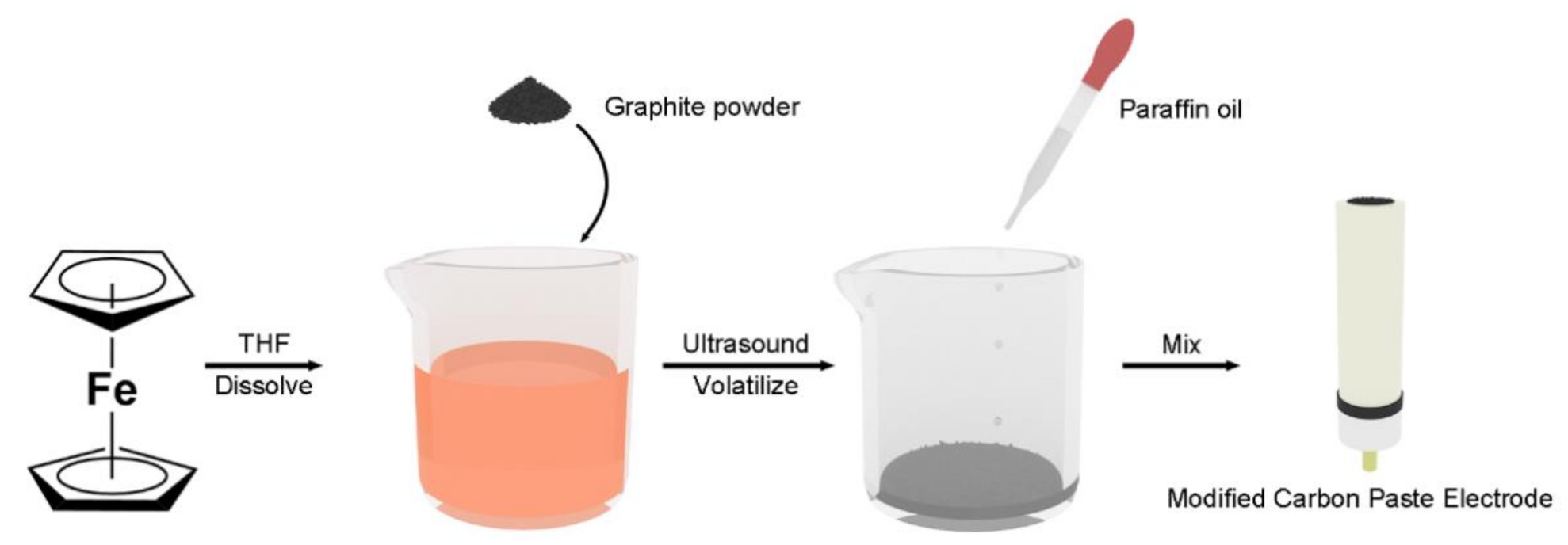
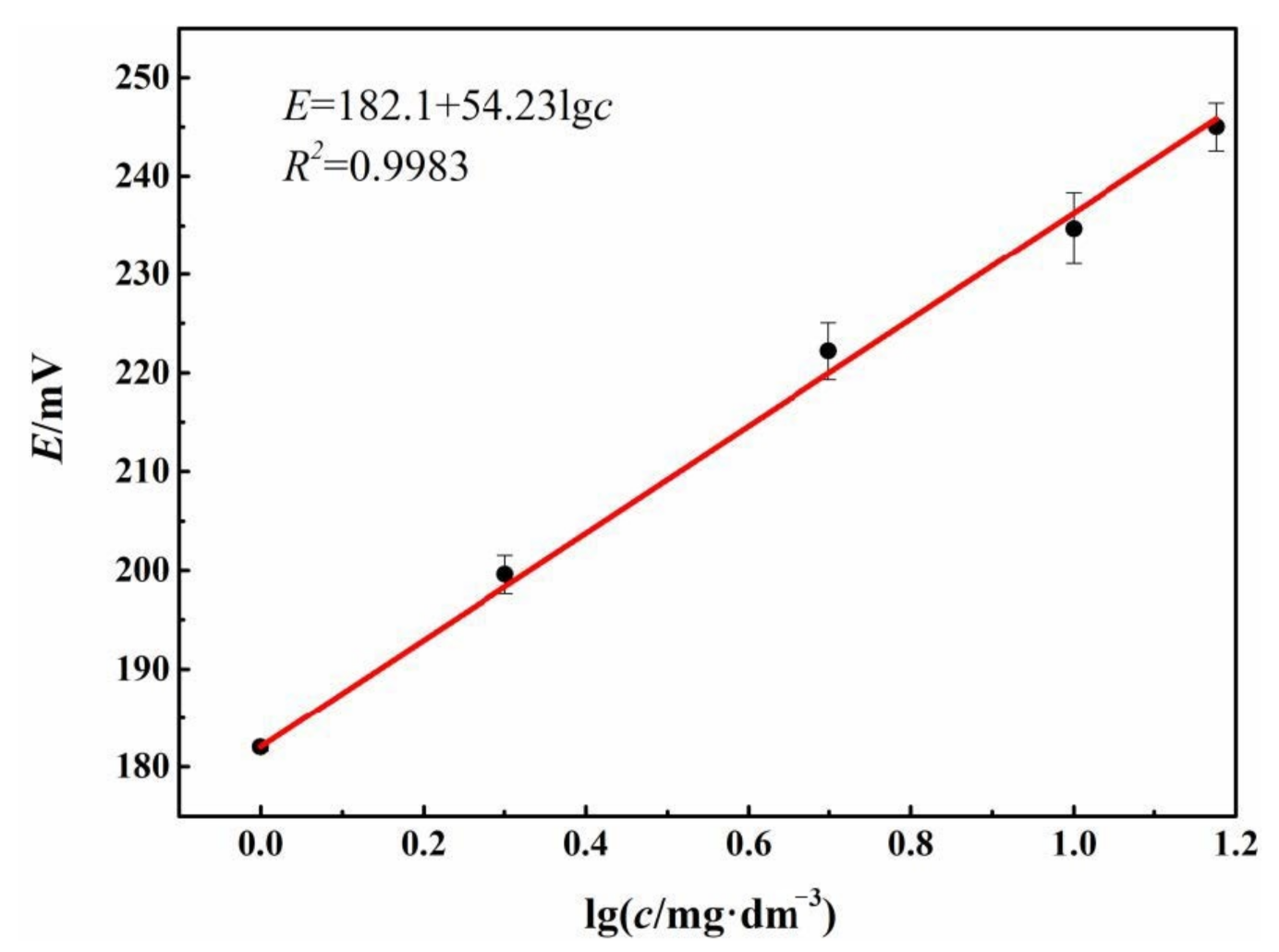
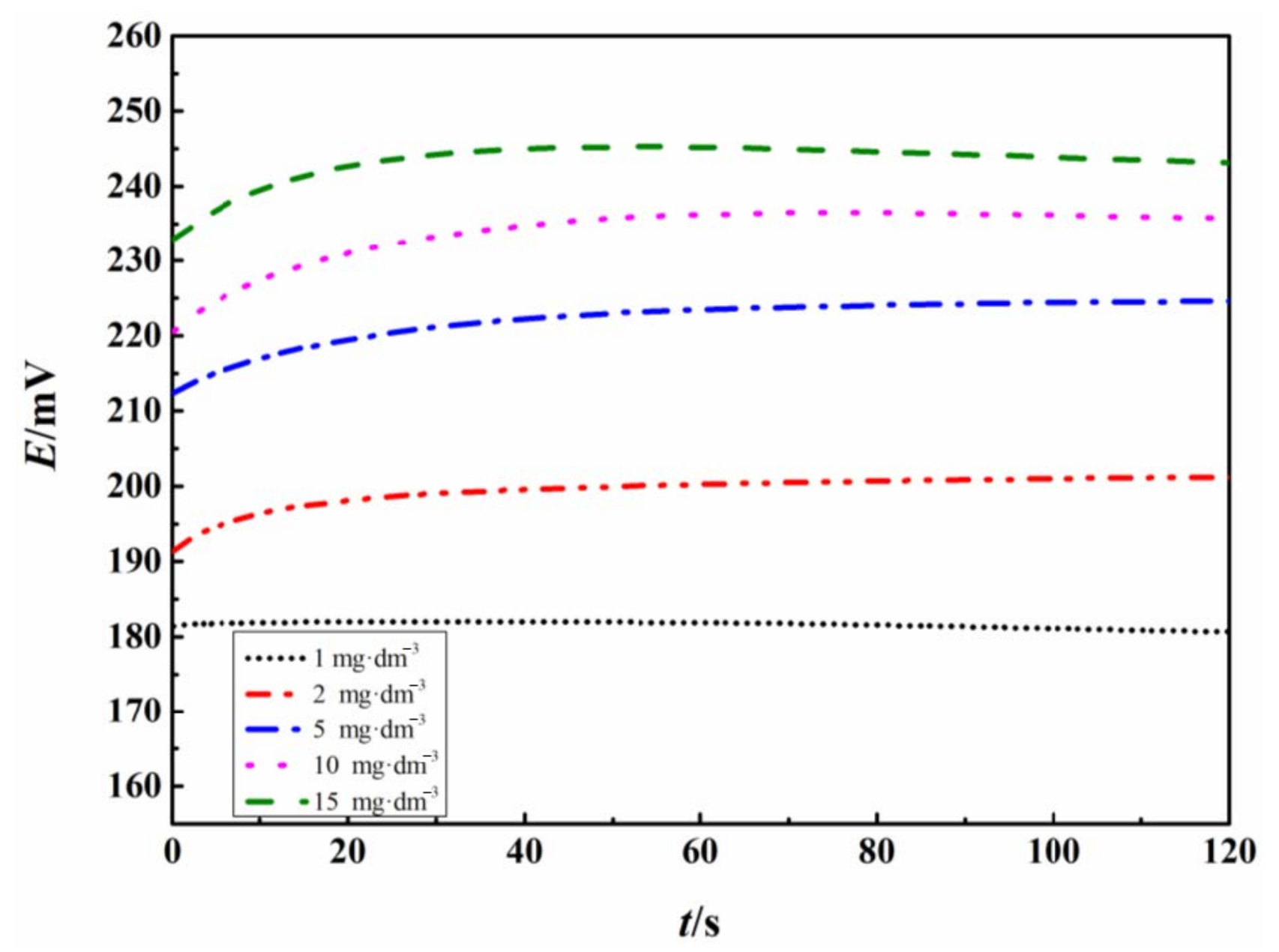
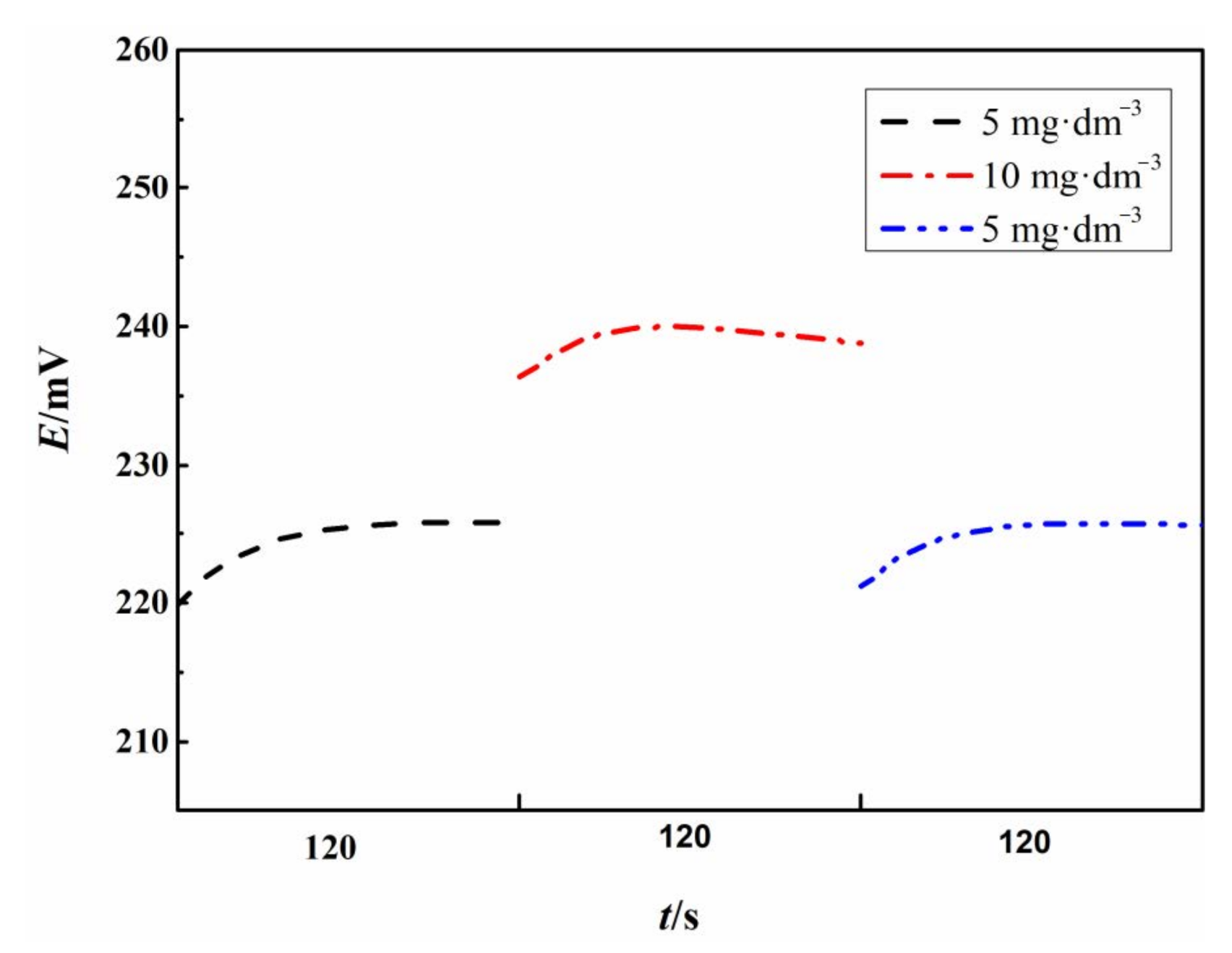
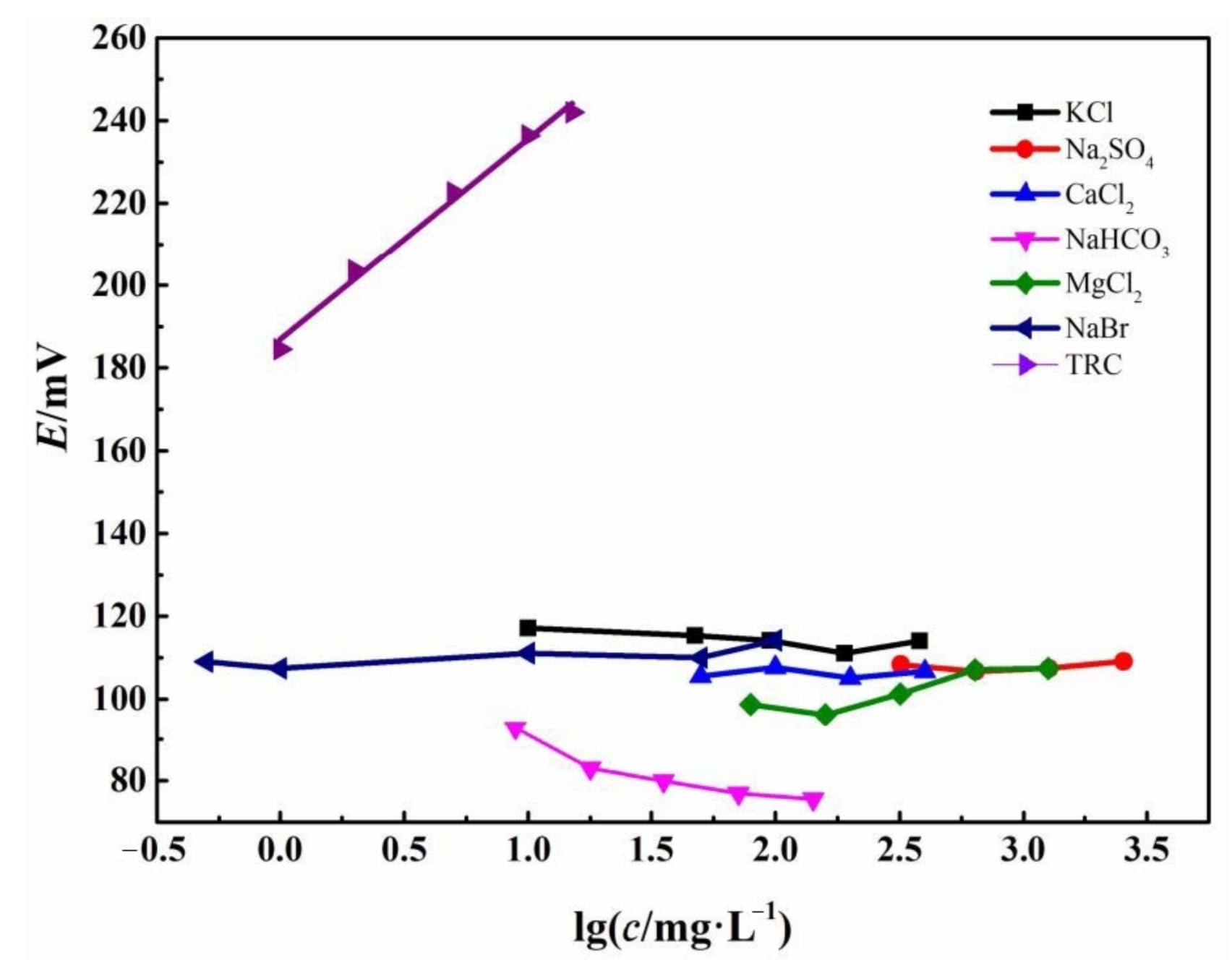
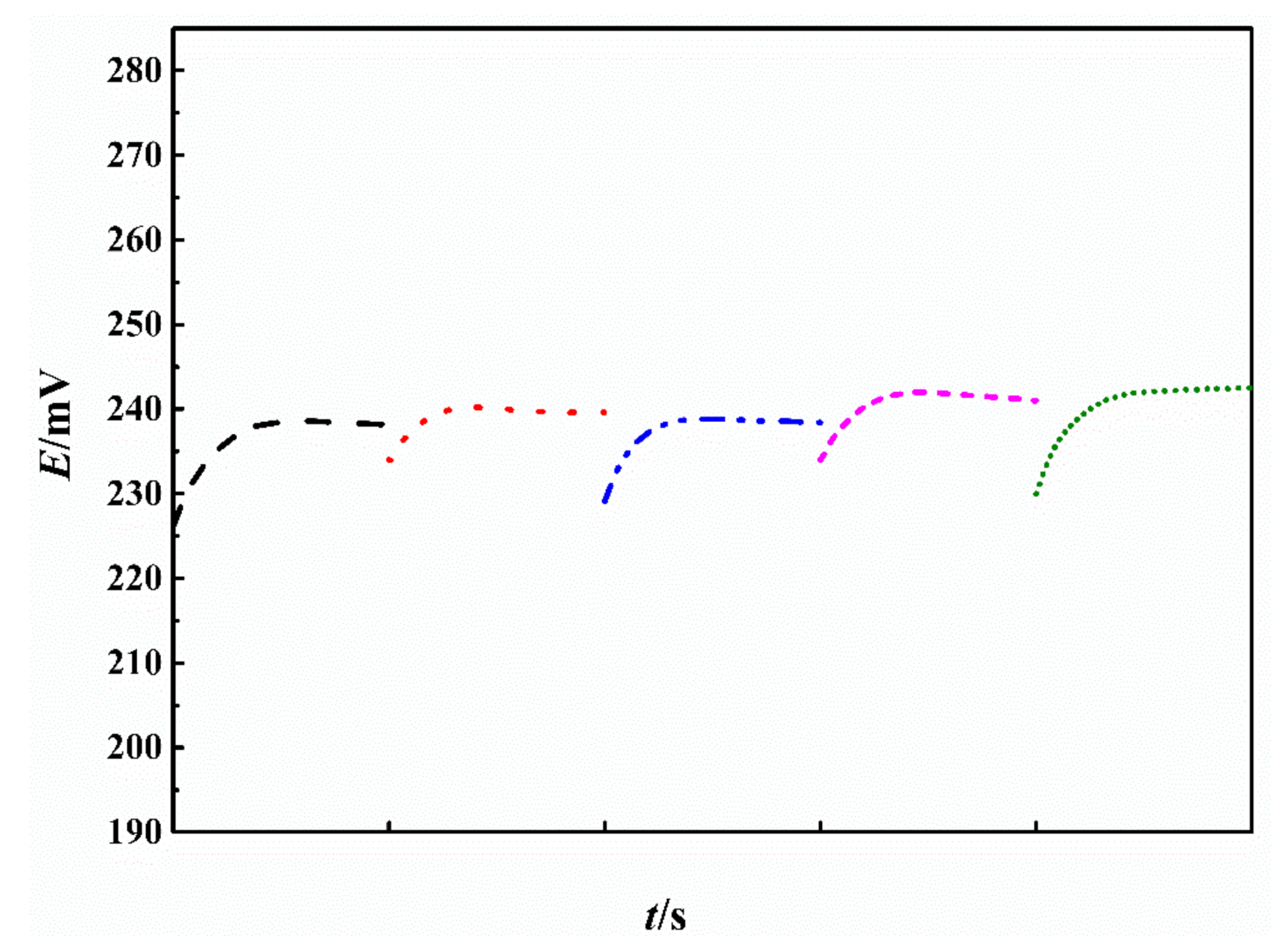

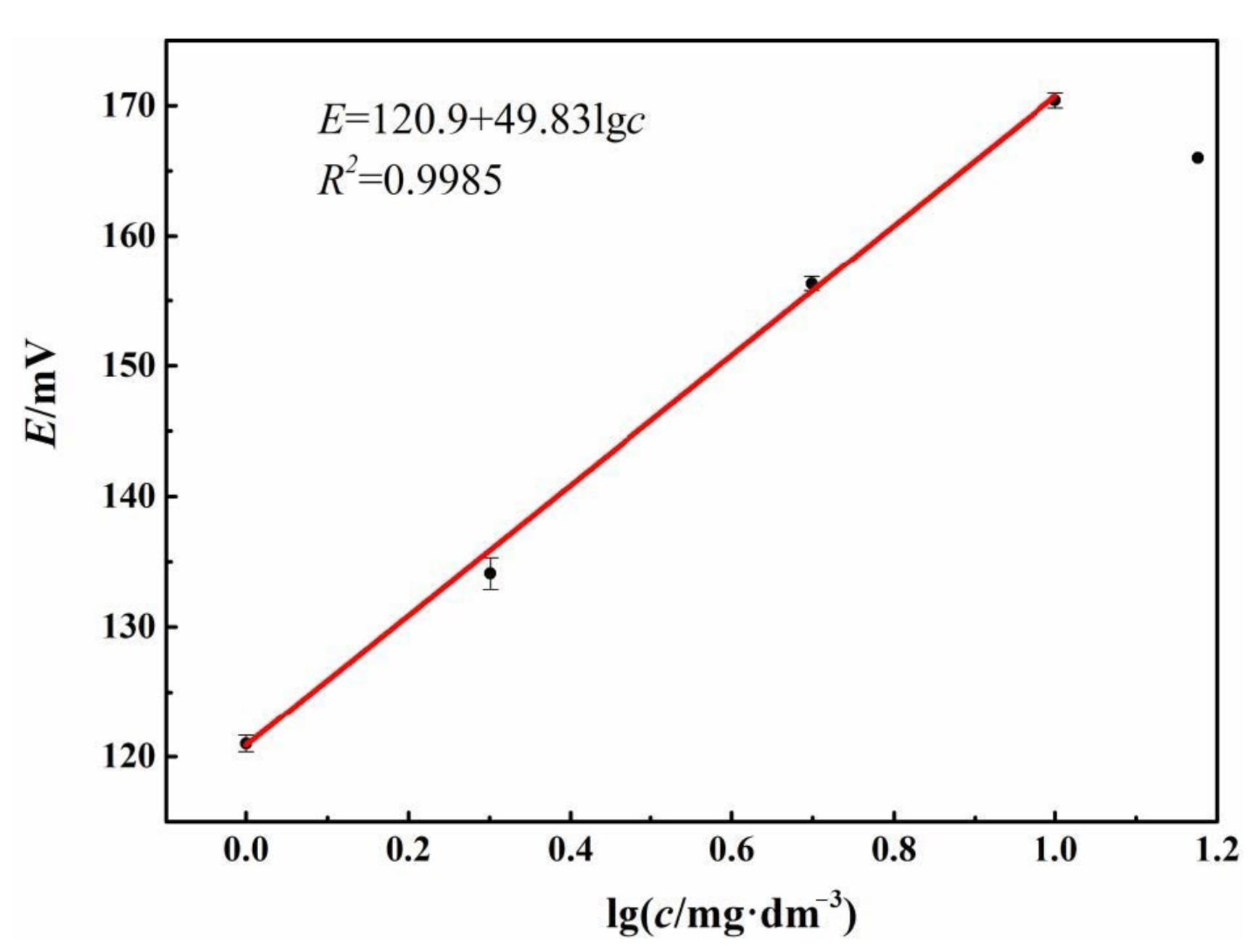
| No. | Composition (/g) | R2 | Respond Time (s) | ||
|---|---|---|---|---|---|
| Paraffin Oil | Graphite Powder | Fc | |||
| 1 | 0.25 | 0.65 | 0 | -- | -- |
| 2 | 0.25 | 0.65 | 0.10 | 0.9583 | 45 |
| 3 | 0.3 | 0.6 | 0.10 | 0.9899 | 50 |
| 4 | 0.25 | 0.60 | 0.15 | 0.9983 | 40 |
| 5 | 0.2 | 0.6 | 0.2 | 0.9833 | 60 |
| 6 | 0.25 | 0.55 | 0.20 | 0.9819 | 42 |
| 7 | 0.20 | 0.55 | 0.25 | 0.9566 | 50 |
Publisher’s Note: MDPI stays neutral with regard to jurisdictional claims in published maps and institutional affiliations. |
© 2021 by the authors. Licensee MDPI, Basel, Switzerland. This article is an open access article distributed under the terms and conditions of the Creative Commons Attribution (CC BY) license (http://creativecommons.org/licenses/by/4.0/).
Share and Cite
Zhang, Y.; Li, Z.; Guo, X.; Liu, G.; Zhang, S. Potentiometric Sensor Based on Carbon Paste Electrode for Monitoring Total Residual Chlorine in Electrolytically-Treated Ballast Water. Sensors 2021, 21, 350. https://doi.org/10.3390/s21020350
Zhang Y, Li Z, Guo X, Liu G, Zhang S. Potentiometric Sensor Based on Carbon Paste Electrode for Monitoring Total Residual Chlorine in Electrolytically-Treated Ballast Water. Sensors. 2021; 21(2):350. https://doi.org/10.3390/s21020350
Chicago/Turabian StyleZhang, Yaning, Zhihui Li, Xiaotong Guo, Guangzhou Liu, and Shuyong Zhang. 2021. "Potentiometric Sensor Based on Carbon Paste Electrode for Monitoring Total Residual Chlorine in Electrolytically-Treated Ballast Water" Sensors 21, no. 2: 350. https://doi.org/10.3390/s21020350
APA StyleZhang, Y., Li, Z., Guo, X., Liu, G., & Zhang, S. (2021). Potentiometric Sensor Based on Carbon Paste Electrode for Monitoring Total Residual Chlorine in Electrolytically-Treated Ballast Water. Sensors, 21(2), 350. https://doi.org/10.3390/s21020350




